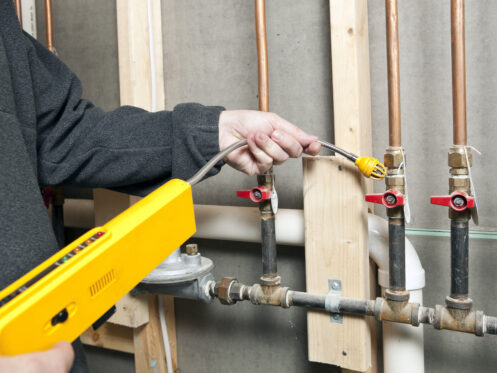The safety and well-being of your family and household are of paramount importance. Undoubtedly, you’ve heard about the dangers of gas leaks, but do you know how to recognize the signs quickly? Understanding what a gas leak can mean for your safety, the health of your family, and even the environment is crucial knowledge for any homeowner. Here’s an overview of the signs and risks associated with gas leaks and what you can do to prevent them.
Common Types of Gases in Households
There are two main categories of gases you’ll find in a typical household: fuel gases and exhaust gases. Fuel gases include propane, natural gas, methane, and butane. These gases are used for cooking and heating homes, but they can be dangerous if not handled properly.
Exhaust gases, on the other hand, are byproducts of incomplete combustion and are usually emitted from poorly maintained appliances and furnaces. These include carbon monoxide (CO), sulfur dioxide (SO2), and nitrogen oxide (NOx).
Signs of a Gas Leak
By understanding the signs, a homeowner can protect themselves, their families, and their property from the dangers inherent when a gas leak develops.
Rotten Egg Smell
Natural gas is odorless, but gas companies add mercaptan before it’s pumped into homes for your safety. Mercaptan smells like rotten eggs or sulfur, so smelling this odor indicates a gas leak.
Hissing Sounds
Natural gas is supplied to your residence via high-pressure pipelines. When a leak develops in a pipe or appliance connection, the pressurized gas escapes through the opening. This escape creates a distinct hissing or roaring sound, depending on the size of the leak.
Visible Damage to Gas Lines
Gas lines are made of metal pipes that can degrade over time. If you notice any visible damage, such as dents, corrosion, or cracks, it could indicate a dangerous situation where a gas leak may develop.
Physical Symptoms
A gas leak can physically affect the body through two mechanisms: oxygen depletion and toxicity. Oxygen depletion occurs when gases such as methane displace oxygen in a confined space, causing suffocation. You’ll start feeling dizzy, lightheaded, and tired.
Toxicity, on the other hand, happens when inhaling high concentrations of harmful gases like carbon monoxide. Symptoms include headache, nausea, confusion, and eye and throat irritation.
Dead or Dying Plants
If you have indoor plants, they can serve as a natural indicator for gas leaks. Plants don’t directly breathe oxygen like humans and animals. However, they require it for a crucial biological process called cellular respiration, which allows them to convert nutrients into energy for growth.
Therefore, when the oxygen level drops due to a gas leak, the roots of your plants can’t absorb oxygen as effectively. As a result, the plant’s metabolic processes will slow down. This oxygen deficiency manifests as wilting leaves, stunted growth, and yellowing or browning leaves.
Higher Than Normal Gas Bills
Your gas meter meticulously tracks how much gas is consumed in your home. If there’s a leak, the meter will detect significantly higher gas usage, even if you haven’t used more gas than usual. This increase in consumption will be reflected in your monthly bill and can serve as an early warning sign of a potential leak.
Risks Associated with Gas Leaks
Understanding the full spectrum of dangers posed by gas leaks is vital. They go beyond mere health risks and can snowball into catastrophic safety hazards and environmental concerns.
Health Risks
Inhaling gas can cause immediate physical harm, from mild irritation of the eyes, nose, and throat to severe long-term health problems or death. Those most vulnerable are children, older adults, and people with respiratory issues who may be more susceptible to the effects of gas exposure.
Safety Risks
The primary component of natural gas delivered to homes is methane (CH4), which is highly flammable. Even the smallest spark can ignite it when mixed with air in the right proportions, leading to fires and explosions that can cause extensive damage to property and pose significant threats to human life.
Environmental Impact
Leaking emissions and fuel gas contain methane, carbon dioxide, and other pollutants that contribute to air pollution and climate change. They are greenhouse gases, which means they absorb heat from the sun, trapping it in the atmosphere and causing temperatures to rise.
What to Do if You Suspect a Gas Leak
The first step is to evacuate the area. You can’t risk passing out or being rendered unconscious. If other people or pets are inside the building, ensure they are also safely evacuated.
Don’t turn on lights or use electronics while finding your way out. Doing so could ignite the gas and cause an explosion.
Turn off the main gas valve once you are a safe distance away. This is usually located near the gas meter, which is typically outside or in a garage.
Immediately after, contact A/C & Plumbing Doctors if you live in Gilbert, AZ. Our experts will assess the situation and determine the best course of action.
Preventing Gas Leaks
Regular Maintenance
Ensure the safety of your home by scheduling maintenance with a professional at least once or twice a year. They will inspect your gas lines and connections for signs of wear and tear, corrosion, or damage. A technician will also look for cracks, loose fittings, or distortions that could lead to leaks.
In addition, they will also check your appliances and make sure they are running efficiently and without any gas leaks. They will also ensure that HVAC equipment like furnaces has not developed cracks or holes in their heat exchangers, which can lead to emissions leaks.
Proper Ventilation
Proper ventilation is crucial in preventing emission gas leaks. Make sure all vents, chimneys, and flues are clear of any debris or blockages that could block emissions from flowing outside.
Installing Detectors
Natural gas and carbon monoxide detectors are essential tools for detecting gas leaks. These devices can sense the presence of gas in the air and sound an alarm, providing early warning before a serious issue develops.
However, like any other device, they’ll only work if you properly install, maintain, and test them regularly. For instance, they need to be placed high on walls or ceilings since natural gas is much lighter than air and will rise. They should also be near any potential sources of gas leaks, such as furnaces, water heaters, and stoves.
Practice Safe Habits
First, you should know where your home’s gas supply valve is located and how to shut it off in case of an emergency. This will help prevent a small gas leak from becoming a major one.
Second, make sure to follow proper safety precautions when using gas-powered appliances. Never use your oven or stove as a heating source, and always turn them off when not in use.
Finally, never attempt to fix or install gas lines yourself unless you are a trained professional. Improperly installed gas piping can cause a deadly leak.
Contact the Professionals
At A/C & Plumbing Doctors, we are a family-owned business that has been serving the residents of Gilbert, AZ for over 20 years. We install, repair, and maintain heating and cooling systems. In addition, we are expert plumbers who provide gas line, drain cleaning, and leak detection services. Contact us today to schedule an appointment with one of our experienced team members.





